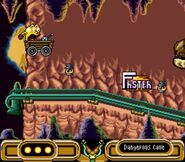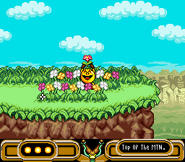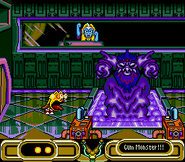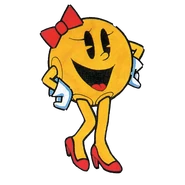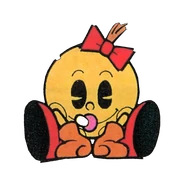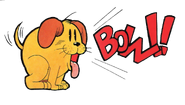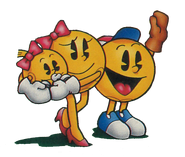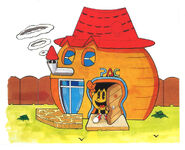Were you looking for Pac-Man II?
Pac-Man 2: The New Adventures, known as Hello! Pac-Man in Japan (ハロー!パックマン Harō! Pakkuman), is an adventure game released by Namco in 1994.
Despite the "Pac-Man 2" name present internationally, the game shares little resemblance to the original Pac-Man game, apart from the game being included.
Gameplay[]
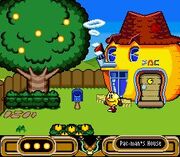
Screenshot of the game, from the outside of Pac-Man's house.
In Pac-Man 2: The New Adventures, the player plays the role of an observer and assistant, that follows Pac-Man as he sets out to accomplish various tasks. Pac-Man himself walks around and interacts directly with the player, as well as with objects and other characters. The player cannot control Pac-Man directly, but instead can direct his attention in various directions, and is armed with a slingshot (represented by a small crosshair) that can be used to strike certain objects, including Pac-Man himself. The game begins with a tutorial stage, but this can be skipped at any time by pressing the Start button.
Pac-Man's mood varies throughout the game, usually in response to his environment or the player's actions, and generally his mood affects his actions and his willingness to cooperate with the player; the varieties of "bad" moods can at time compromise the player's ability to progress. There are a few instances, however, where Pac-Man is required to be angry or frightened in order to discover or activate important objects. Hitting objects with the slingshot can often get Pac-Man to look at that object and piece together parts of the puzzle he is currently trying to solve - for example, hitting a door may cause Pac-Man to go inside a house to discover a clue. Some objects when hit can also produce disastrous (and humorous) results. Hitting a trash can on a city street at the wrong time, for example, can cause a cat to jump out and attack Pac-Man. There are instances where Pac-Man faints and must be awakened by hitting him with the slingshot. There are also some instances where Pac-Man passes out, for example, he is attacked by a cow's tail, the player attacks Lucy, the hot dog vendor splatters sauce over Pac-Man's face, Pac-Man is badly damaged or falls into a bottomless pit. If Pac-Man is knocked out, the "cartoon" will end and the player will begin back at the beginning of the current section where Pac-Man passed out. Upon respawning after passing out, Pac-Man's starting mood will be sad.

Pac-Man obtaining the flower from the Top of the Mountain
Throughout the game, Pac-Man is occasionally harassed by the four ghosts; when this happens, Pac-Man is paralyzed by fear and eventually faints. However, if the player gives Pac-Man a Power Pellet, he turns into Super Pac-Man for a brief time and flies around, allowing him to eat the blue ghosts. Up to three Power Pellets can be held at a time, and more can be found growing on trees or by finding them across the locations. In some cases, the ghosts may leave behind important objects, like key items or ID cards which are required to progress further with the story. Power Pellets also return Pac-Man back to his normal or happy state after the Super transformation wears off.
Pac-Man travels across four themed locations across his journey, including the Village, Mountain, Metropolis and the Factory. The player is initially blocked out of access to the Mountain, Metropolis and Factory due to the lack of a pass, which is handed out by Ms. Pac-Man at the start of the second and third missions respectively. There are certain segments known as "Action Stages" in which Pac-Man mounts a hang glider or minecart, which require more direct interaction with Pac-Man than usual. These segments commonly share controls of using the Look button and using the slingshot to shoot Pac-Man to avoid obstacles or fending off the ghosts' attacks. "Action Stages" are completed by reaching the end goal of an area. The general goal of the first three missions is to find the specified object within the areas, and return to Pac-Man's house.
In order to complete the fourth and final mission, Pac-Man must acquire three IDs, which are dropped by the ghosts when they are eaten. The IDs are used to open the gate to the Ghost Witch's lair, located inside the Factory, and must be inserted in an indicated order. When this is successfully completed, Pac-Man must face the Gum Monster, the only boss in the game. Pac-Man must become Super Pac-Man and stop the ghosts from adding more gum to the Gum Monster, while the player must repeatedly attack the Gum Monster to shrink him. If the Gum Monster becomes too big, the Gum Monster will become powerful enough to grab Super Pac-Man and flatten him, starting over the boss fight. The boss fight is completed by shrinking the Gum Monster enough for him to melt and recedes back into the gum pool, completing the game.

The player can play Pac-Man and Ms. Pac-Man (Pac-Jr. in the Genesis version) by visiting the arcades in the Village and Metropolis. Ms. Pac-Man (Pac-Jr.) is unlocked by discovering the three hidden cartridges within the game.
Pac-Man can play ports of Pac-Man and Ms. Pac-Man (or Pac-Jr., an original game in the Sega Genesis version with similar rules to Ms. Pac-Man but has different mazes) by visiting the arcades in the Village and Metropolis. Each of the ports are based off their NES counterparts. The player can play the original Pac-Man game at the start; however the Ms. Pac-Man (or Pac-Jr.) machine is out of service, and requires Pac-Man to find three cartridges spread across the Village, Metropolis and Mountain.
By pressing the start button, the player is able to check their inventory. The inventory displays all Power Pellets, Ms. Pac-Man/Pac-Jr. cartridges and any mission-important items in hand. There is also a password located at the bottom, which allows the player to continue from the start of that area with their remaining items if it is entered from the title screen. The passwords can also be used to instantly start Pac-Man and Ms. Pac-Man (Pac-Jr.) without entering the main game.
Story[]
Note: some parts of this section may be considered spoilers.
The game centers around Pac-Man as he sets out to complete a series of tasks for his family.
The Practice Stage[]
Pac-Man introduces the player to his world and guides him on how to use the controls, and how to co-operate with him. Once Pac-Man completes his explanations, Ms. Pac-Man calls Pac-Man for his first mission.
Mission 1: Hunt and Gather[]
Ms. Pac-Man tells Pac-Man that Pac-Baby has run out of milk and is still hungry; she tasks Pac-Man to find some milk. Pac-Man travels to the local barn to get milk from a cow. Pac-Man finds an empty bottle to use, but is too short to reach it. The player shoots a crow that chases Pac-Man, but also knocks down the bottle, letting Pac-Man milk the cow and return home. Pac-Man returns home and gives Ms. Pac-Man the bottle, who then gives it to Pac-Baby; who chugs down the milk bottle quickly. Blinky, Pinky, Inky and Clyde are seen entering the Ghost Witch of Netor's lair, where they meet up with a furious Ghost Witch and are zapped out of their bodies as punishment for failing to stop Pac-Man.
Mission 2: Birthday Surprise[]
While watching TV, Ms. Pac-Man tells Pac-Man that Lucy, a friend of Pac-Jr.'s is having her birthday soon and tasks Pac-Man to get flowers from the mountain as a surprise. Ms. Pac-Man gives Pac-Man a Ropeway pass which lets him use the ropeway that goes to the mountain top. Pac-Man then climbs a rope to the mountain top and uses a lost hang glider to travel across the mountain while dodging the ghosts. Pac-Man makes it to the end of the mountain and finds the flower bush. Pac-Man takes a flower and finds a hole which brings him back in front of the ropeway station gate. Pac-Man returns home, only to find out that Lucy's birthday party had already started and was given a different flower by Ms. Pac-Man. Realizing his task was for nothing, Pac-Man shrugs at the camera. The ghosts return to the lair and are once again zapped by the Ghost Witch.
Mission 3: Rock 'n' Roll[]
Pac-Jr returns home crying, with Lucy accompanying him. He explains to his parents that the Ghosts stole his guitar and took off into the Metropolis. Pac-Man promises Pac-Jr. that he'll find his guitar, and gets a train pass from Ms. Pac-Man that lets him travel to the Metropolis. Pac-Man travels to the Metropolis and encounters a security guard, whom Pac-Man picks a fight with. When the guard is shot enough times by the player, the Ghosts will drop their disguises and scare Pac-Man, also revealing that one of them has Pac-Jr's guitar. Pac-Man must become Super Pac-Man to chomp the ghosts and then recover his guitar. After Pac-Jr's guitar is recovered, Pac-Man returns home and gives Pac-Jr's guitar back to him. The family gathers to hear Pac-Jr.'s guitar solo, and imagines that Lucy will love his song. The ghosts return to the lair and are yet again zapped by the Ghost Witch.
Mission 4: Defeat the Ghost Witch[]
While watching TV, Pac-Man comes across a news segment in which the ghosts are seen stealing already-chewed ABC gum from children in the Metropolis, last seen headed towards the factory. The news signal is hijacked and taken over by the Ghost Witch of Netor, who announces to Pac-Man that she's had enough of his meddling and is nearly complete with her Gum Monster, proclaiming that he will be the one that will get chomped on this time. Pac-Man sets off to work his way through the abandoned factory where the monster is being created and eventually finds the Ghost Witch's lair. In order to access to the lair, he uses the three IDs dropped by the ghosts to enter the lab where the Gum Monster is. Pac-Man is spotted by the Ghost Witch and prepares for the final battle against her Gum Monster upon entering the lair. He eats a Power Pellet to become Super Pac-Man to fight off the Ghosts, while the player fights the Gum Monster with a slingshot; but the Gum Monster attacks Pac-Man, sending him crashing into a wall. The Gum Monster is eventually defeated and melts back into a pool of gum. The Ghost Witch retreats with her ghosts to plan their next evil scheme, and Pac-Man is congratulated by the children of the Metropolis (except for one since he didn't save their ABC gum) and his family as he becomes a true hero at the end.
Characters[]
Pac-Family and Friends[]
Ghosts and Main Antagonists[]
Outdoor Animals[]
- Gizmo the Attack Cat
- Bull-Dog
- Cassie the Cow
- Vel-Crow
Others[]
- George the Crazy Car Driver
- Ron the Restaurant Owner
- Farmer Fred
- Dottie the Department Store Clerk
- Pablo the Painter
- Horace the Hot Dog Vendor
- Dan and Veronica, two kids from Pac-City
- Ted and Jed, the Crooks
- Rick the Ropeway Conductor
- Howard the Balloon Guy
- Dennis the Door Slammer
Home Ports[]
- Classics Games Pass
- A Japan-only service available on iOS and Android, which runs through an AU Smartpass subscription. Presumably based on the Super Famicom version.
- Sega Genesis
- Released exclusively in North America. As mentioned in gameplay, the unlockable Ms. Pac-Man game is replaced with an original game, titled Pac-Jr.
- Super Famicom/SNES
- Tabletop Arcade Machine
- Included on the My Arcade Namco Museum Mini Player. Same as the Sega Genesis version (save for altered copyrights).
- Wii U
- Re-release of the Super NES version as part of the Virtual Console lineup.
Trivia[]
- This game states Baby Pac-Man's gender as female. It is the only Pac-Man game to do so, as all others state Baby Pac-Man is either male or never specifies.
- In the SNES version, the music's tempo changes depending on Pac-Man's mood. For example, when Pac-Man is angry, the tempo gets faster.
- Pac-Man 2: The New Adventures alters the designs of most of the recurring characters, including Pac-Man, his family and the ghosts. Each of the characters have been given a westernized look, with the most common traits between the redesigns being the addition of white eyes and teeth between the Pac-Man family members. Despite this, most 2D artwork for the game depict Pac-Man's family with their classic pie-shaped eyes and eyebrows.
- Pac-Man now has white eyes and has rounder eyebrows connected to his skin. He also has brown gloves and now wears traditional sneakers instead of boots. When Pac-Man transforms to Super Pac-Man, he is seen again in his red boots.
- Some of the design aspects of Pac-Man's design would be reused in Pac-In-Time and and the Philips CDi version of Pac-Panic. In the latter, the only change is Pac-Man's gloves being red instead of brown.
- Ms. Pac-Man's legs are depicted as more model-like, wears eye paint, lipstick, white gloves and high heels in-game. In artwork, she is depicted without her eye paint and lipstick.
- Some of the design aspects would be reused in Ms. Pac-Man's game room appearance in Namco Museum Vol. 3 and Pac-In-Time.
- Jr. Pac wears a cap instead of a propeller hat. Though he wears red shoes in-game, he is depicted with blue shoes in artwork.
- Though her 2D artwork depicts her design as unchanged from her Japanese artwork, Baby Pac has a white pacifier, gloves and shoes in-game.
- Chomp-Chomp is now colored yellow and brown and has more dog-like legs. This is the first instance of Chomp-Chomp being depicted with a yellow color
- The Ghost Gang have much wider mouths.
- Pac-Man now has white eyes and has rounder eyebrows connected to his skin. He also has brown gloves and now wears traditional sneakers instead of boots. When Pac-Man transforms to Super Pac-Man, he is seen again in his red boots.
- The design of Pac-Man's house featured in this game would later be reused in Namco Museum Vol. 1 and Vol. 3.
- Pac-Man 2: The New Adventures is one of only two games to have development credits for Mandrill Club, the other being Super Waygan Land 2. Details about the studio are largely obscure; it is theorized by some that Mandrill Club may be a subsidiary of Namco, as they are only credited in this game and Super Wagyan Land 2, also released by Namco.
- Strangely, the line of text actually reading "development" above Mandrill Club's name is Japanese in all versions of the game, including English releases.
- While the original print run of the Sega Genesis version was published by Namco, later prints were published by Ballistic (a division of Accolade) instead. This may have been done as a loophole to prevent contractual issues with Nintendo, who were notoriously strict about companies publishing games on both Nintendo and Sega platforms.
- Instead of having "Namco" printed into the back cartridge plastic, reprinted copies would sometimes have "Ballistic", "Sega", or "Acclaim" printed instead.
- Though the game was developed in Japan, Pac-Man 2: The New Adventures was first released in North America. (unlike the majority of other 90s to mid-2000s Pac-Man games, which were mainly developed in America).
- Early screenshots of the game from EGM October 1993 indicate that Sue was originally planned to be part of the Ghost Gang; her role was reduced to only appearing at the entrance gate of the Ghost Witch's lair as a security guard in the final SNES version of the game.[1]
- The game resembles both the preceding Pac-Man TV Series (1982-1983) and its successor, Pac-Man and the Ghostly Adventures (2013-2015). It can be concluded that it was inspired by the first show, and that the second show took inspiration from it in turn.
- There is only one Power Pellet Tree in the game, as in Ghostly Adventures, but it produces one type of power pellet and is fairly small, as in Pac-Man 1982.
- The game and Ghostly Adventures share the title format "Pac-Man ___ The ___ Adventures".
- The humanoid Ghost Witch commanding the Ghost Gang around, while never taking initiative herself, is reminiscent of Mezmaron's behavior.




